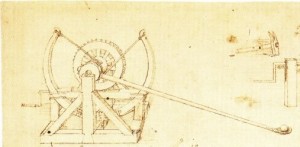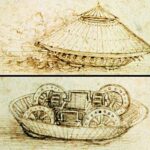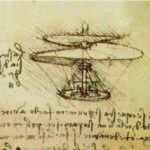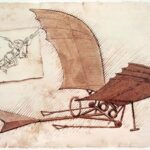Did da Vinci Design a Catapult
Table 1. Summary of the Leonardo da Vinci Catapult:
| Section | Sub-Section | Key Points |
|---|---|---|
| Introduction | Leonardo and his Catapult | – Explores da Vinci’s genius, focusing on his catapult design. |
| Unveiling the Da Vinci Catapult | Exploring da Vinci’s Innovative Design | – Analysis of da Vinci’s catapult design and its distinct features. |
| Physics Behind the da Vinci Catapult | – Examination of the underlying physics of da Vinci’s catapult. | |
| The Role of Leonardo’s Catapult | Da Vinci’s Intended Use | – Study of the historical application of da Vinci’s catapult. |
| The Catapult in Today’s World | – Overview of how catapults, drawing from da Vinci’s design, are used today. | |
| The Terminology | Understanding the Terminology | – Explanation of various names and titles used to describe da Vinci’s catapult. |
| Unraveling Catapults through History | The First Known Catapults | – Exploration of the first known inventors of the catapult. |
| Tracking Changes in Catapult Blueprints | – Tracks the evolution of catapult designs throughout history. | |
| Catapults in the Middle Ages | – Discussion of the role of catapults in medieval warfare. | |
| Comparing Catapult Designs | da Vinci Versus Mangonel | – Comparison between da Vinci’s catapult and the mangonel. |
| Understanding Mangonel Physics | – Delving into the physics behind the mangonel. | |
| Torsion Catapults | – Analysis of the design and blueprints of torsion catapults. | |
| The Best Catapults Throughout History | – Evaluation of the best and most efficient catapult designs throughout history. | |
| Facts and Curiosities | Fun Facts About Catapults | – Presentation of fun and unusual facts about catapults. |
| da Vinci’s Catapult: Lesser-Known Facts | – Sharing lesser-known facts specifically about da Vinci’s catapult. | |
| Modern Day Uses of Catapults | – Discussion on the uses of catapults in modern times. | |
| Leonardo da Vinci: The Inventor | Da Vinci’s Other Inventions | – Review of da Vinci’s other inventions beyond the catapult. |
| What He Truly Invented | – Analysis of what da Vinci truly invented in his lifetime. | |
| Conclusion | The Impact of Da Vinci’s Catapult | – Recapitulation of the significance and enduring impact of da Vinci’s catapult. |
I. Introduction
I) Leonardo and his Catapult
Leonardo da Vinci’s contributions spanned a plethora of domains, one of which was the art of warfare. Within the folios of his sketches, we find a truly extraordinary machine, a mechanical marvel that was as ingenious as it was intimidating: Leonardo da Vinci’s catapult.
The da Vinci catapult was not a mere device of destruction, but rather a testament to Leonardo’s innovative prowess. It was an embodiment of his fascination with the principles of motion and leverage, a literal manifestation of da Vinci catapult physics.
It did not matter if it was called the Leonardo da Vinci catapult, the da Vinci catapult, or in the mellifluous cadence of his native Italian, the Leonardo da Vinci catapulta. This ingenious war machine marked a paradigm shift in the catapult designs of the era.
II. Unveiling the Da Vinci Catapult
II) Exploring da Vinci’s Innovative Design
Da Vinci’s catapult was a masterstroke of creativity and precision. Unlike the more conventional mangonel catapult designs seen during the period, the da Vinci catapult employed a unique spring mechanism. This consisted of a pair of large leaf springs made of wooden strips, providing a power source that could be adjusted to deliver a range of firing forces.
When released, these springs would drive the armature forward, launching the projectile with greater precision and consistency than earlier designs. As a result, the Leonardo da Vinci catapult marked a significant leap in the evolution of siege warfare, providing a new level of versatility and control.
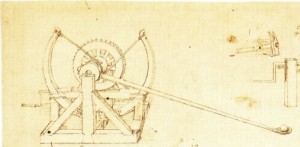
Leonardo da Vinci Catapult
II) Physics Behind the da Vinci Catapult
When we delve into the physics of da Vinci’s catapult, it becomes evident how his deep understanding of natural laws allowed him to revolutionize the way catapults were designed and used. The key was in the way he harnessed the potential energy stored in the spring mechanism.
The tightly wound springs of the Leonardo da Vinci catapult could be carefully calibrated, allowing for the precise control of the catapult’s kinetic energy. When the release mechanism was triggered, this stored energy would rapidly convert to kinetic energy, propelling the armature and its payload towards the target. The genius lay in the consistency and control this design afforded, providing a degree of accuracy that was previously unheard of in catapult designs.
III. The Role of Leonardo’s Catapult
I) Da Vinci’s Intended Use
The Leonardo da Vinci catapult, like many of his designs, was an idea far ahead of its time. It is important to remember that da Vinci lived during a period when warfare was an all too common occurrence, and siege machines like catapults were essential in battleground strategy. However, Leonardo’s vision of the catapult was not solely for destruction.
The da Vinci catapult, with its precision and adjustable range, could have been utilized for more than just siege warfare. It could deliver supplies over city walls during a blockade or serve as a signal launcher in naval navigation. In essence, Leonardo envisaged the catapult as a versatile tool, not just a weapon of war, demonstrating his comprehensive understanding of the broader applications of his designs.
II) The Catapult in Today’s World
Fast forward to the present, and we can see the influence of the Leonardo da Vinci catapult in modern engineering and design. Today, the principles of da Vinci catapult physics have found their way into diverse fields, from mechanical engineering to education and entertainment.
In the world of mechanical engineering, the fundamentals of catapult operation serve as a basis for understanding more complex machinery. The concept of storing potential energy and converting it to kinetic energy, central to the function of Leonardo’s catapult, can be found in various mechanisms used today, from automotive engines to power tools.
Even in education, students are often tasked with creating catapult designs, utilizing the same principles employed in the da Vinci catapult to learn about physics and engineering. It’s not uncommon to see a modern davinci catapult in a science fair or physics classroom as a hands-on demonstration of principles like potential and kinetic energy, force, and trajectory.
IV. What is Da Vinci’s Catapult Called?
I) Understanding the Terminology
In the realm of Renaissance engineering and innovation, da Vinci’s designs hold a special place. Among them, the Leonardo da Vinci catapult is often singled out for its unique design and forward-thinking approach to energy conversion. But is there a specific name for this exceptional invention?
Interestingly, while the name ‘da Vinci catapult’ is widely used in popular culture and academia, Leonardo himself didn’t give a particular name to his design. His sketches and notes, dense with insight and overflowing with ideas, were more focused on functionality and design principles rather than nomenclature. Hence, we refer to it by its most descriptive name: the Leonardo da Vinci catapult.
However, it’s worth mentioning that in Italian, the language in which da Vinci wrote his notes, the term ‘catapulta’ is used. So, for Italian-speaking people, the term Leonardo da Vinci catapulta would be the appropriate one. Regardless of the name we use, the ingenuity and innovation encapsulated in this design are universally appreciated.
Another term often associated with da Vinci’s catapult is ‘davinci trebuchet’. A trebuchet is a type of catapult, distinguished by its use of a counterweight to launch projectiles. While da Vinci did design a counterweight-based catapult, his spring-loaded catapult design is a different mechanism altogether. Therefore, the term davinci trebuchet does not correctly apply to the Leonardo da Vinci catapult.
V. Unraveling Catapults through History
I) The First Known Catapults
The question of who invented the catapult takes us back to the ancient world. The first known catapults were developed in ancient Greece in the 4th century BC, specifically by a Syracuse engineer named Dionysius the Elder.
These early devices, unlike the da Vinci catapult, relied on torsion power from twisted ropes or sinew rather than tension or counterweights. This type of catapult, also known as a mangonel catapult, used the stored energy in the twisted ropes to hurl projectiles towards the enemy.
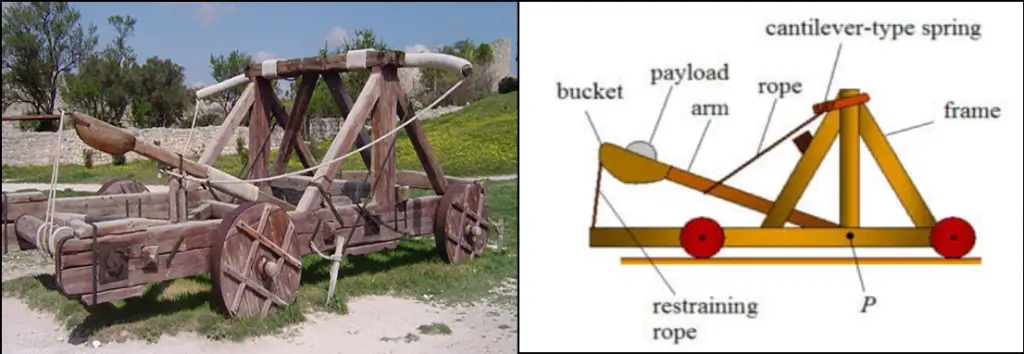
Mangonel Catapult
II) Tracking Changes in Catapult Blueprints
As centuries passed, catapult design blueprints saw significant changes. Greek and Roman engineers refined and diversified catapult designs, introducing new mechanisms like the ballista and onager. It’s fascinating to compare these classical designs with the more sophisticated da Vinci catapult, a testament to the evolution of engineering over the millennia.
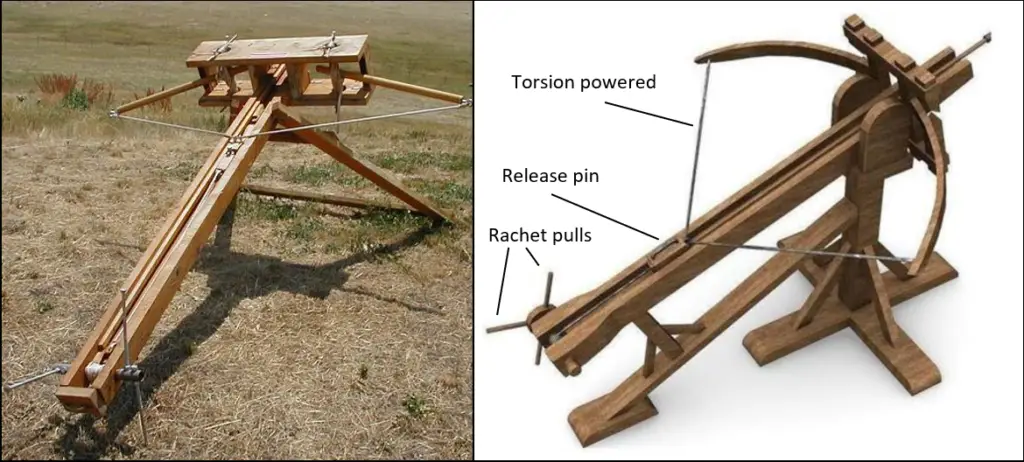
Ballista Catapult
In East Asia, the Mongolians took catapult technology to new heights, creating the Mongolian catapult or Hwacha. This innovation could fire multiple projectiles at once, a stark contrast to the single-projectile designs common in the west.
III) Catapults in the Middle Ages
Entering the medieval period, catapult technology saw another shift. The most prominent type of catapult used in the medieval period was the trebuchet. This siege weapon used a counterweight mechanism, differing from the tension-based design of the da Vinci catapult.
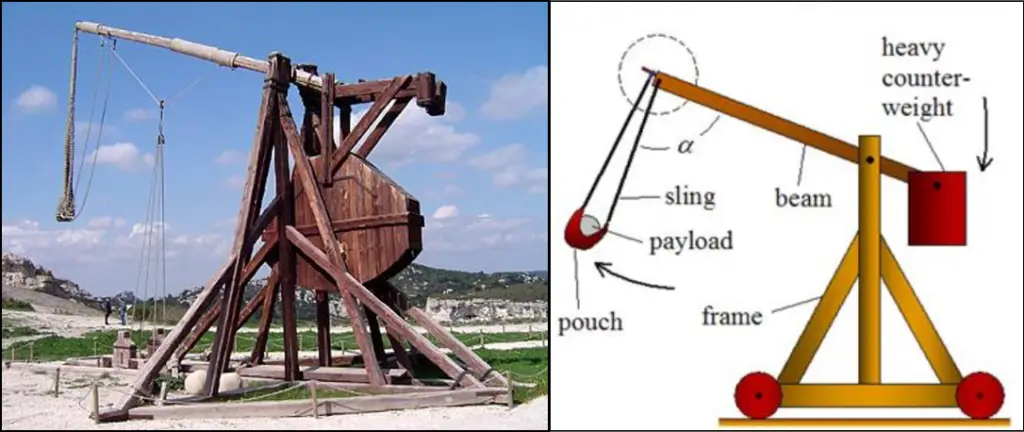
Trebuchet Catapult
Trebuchets represented the apex of medieval siege technology, capable of hurling large projectiles at great distances. The introduction of counterweight technology marked a significant departure from the torsion catapult design of the ancients, leading to more powerful and efficient siege engines.
Despite the differences in design and the centuries that separate them, the trebuchet and the Leonardo da Vinci catapult share a common purpose: to use mechanical advantage to achieve power and precision beyond human capabilities.
VI. Comparing Catapult Designs
I) da Vinci Versus Mangonel
| Catapult Type | Propulsion Mechanism | Construction Complexity | Accuracy |
|---|---|---|---|
| Da Vinci Catapult | Spring-like tension mechanism | More complex | High |
| Mangonel | Torsion (twisted rope) | Simpler | Lower |
II) Understanding Mangonel Physics
Unlike Leonardo da Vinci’s catapult, the mangonel catapult physics were based on the principle of torsion. Essentially, the mangonel stored energy in a twisted bundle of rope or sinew, and this energy was unleashed to power the arm of the catapult. The mangonel was simpler to build than Leonardo’s design, making it a prevalent choice in the ancient world.
III) Torsion Catapults
In the realm of torsion catapult design, the mangonel stood as a dominant force. The torsion catapult blueprints were straightforward, mainly involving a sturdy frame, a pivoting arm, and a torsion bundle. Despite its simplicity, the mangonel could launch projectiles great distances, proving itself a potent weapon in the ancient world, a stark contrast to the more complex da Vinci catapult.
IV) The Best Catapults Throughout History
Over the course of history, catapults have continually evolved, with each design aiming to be the most efficient catapult ever created. Despite its relative simplicity, the mangonel was an incredibly effective tool for its time. However, Leonardo’s catapult design was arguably more efficient, offering superior accuracy and ease of reloading.
Another contender for the title of ‘most efficient’ is the trebuchet, which used gravity instead of torsion or tension, resulting in a powerful and accurate weapon. Despite the relative latecomer status of the davinci trebuchet, it’s another example of Leonardo’s innovative thinking, applying a counterweight mechanism to this ancient warfare technology.
VII. Facts and Curiosities
I) Fun Facts About Catapults
Here are some fun facts about catapults that might surprise you:
- The Greek engineer Dionysius, also known as who invented the catapult, first developed it in 399 BC.
- The word ‘catapult’ comes from the Greek words ‘kata’ meaning ‘downwards’ and ‘pallo’ meaning ‘to toss’.
- During the Middle Ages, some catapults were used to launch diseased animals or corpses over castle walls to spread disease among the enemy. A disturbing yet fascinating example of early biological warfare.
- The largest catapult ever recorded in history was built by Edward I of England during the siege of Stirling Castle in 1304. It was named ‘Warwolf’.
- In the modern world, what is a catapult used for today varies from launching aircrafts from aircraft carriers, pitching machines in baseball, to launching lifeboats.
II) da Vinci’s Catapult: Lesser-Known Facts
There are a few Leonardo da Vinci catapult facts that might not be commonly known:
- Leonardo da Vinci’s design for a catapult was more sophisticated and powerful than the ones used in his time. His catapult was designed for accuracy, not just power.
- Da Vinci’s design used a spring-like tension mechanism, unlike the torsion-based catapults of the ancient world.
- There’s no record that da Vinci’s design was ever built during his lifetime. It existed only as sketches in his notebook until modern enthusiasts brought it to life.
- In Italian, the word ‘catapulta’ is used, hence it’s sometimes referred to as Leonardo da Vinci catapulta.
III) Modern Day Uses of Catapults
In contrast to their original role as siege engines, what is a catapult used for in modern times is remarkably diverse. The physics principles that catapults employ have found applications in various modern technologies:
- In the aviation industry, catapults are utilized to launch planes from aircraft carriers, enabling them to get airborne in a short distance.
- Various forms of catapults are used in the entertainment industry, from amusement park rides to film and stage effects.
- Sports equipment like pitching machines in baseball employ a catapult mechanism.

Aircraft Catapult in Aircraft Carrier
Conclusion
It’s impossible to discuss the history and development of catapults without acknowledging the significant contributions of Leonardo da Vinci. The da Vinci catapult, with its innovative design and the fascinating physics behind it, is a testament to Leonardo’s genius and far-reaching vision.
Although not brought to life during his time, the Leonardo da Vinci catapult has not only provided us with a deeper understanding of the genius that was Leonardo but also has served as an inspiration for modern mechanical studies and designs.
The impact of Leonardo’s catapult design extends beyond just warfare. Today, variations of the catapult are used in various fields, showcasing the adaptability of Leonardo’s designs. From launching aircrafts on naval carriers to educational tools in physics classes, the catapult’s usage in the modern world reflects its enduring relevance.
